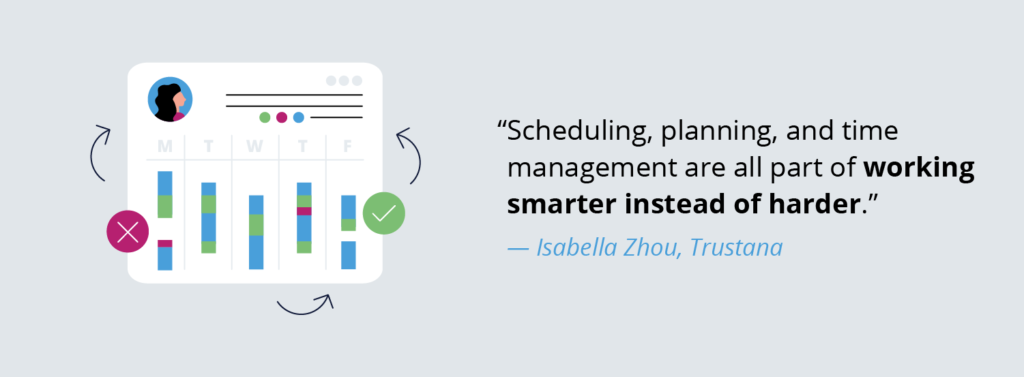Anyone who has ever sang along to Loverboy’s “Working for the Weekend” might know what it’s like to not fully love your job. But what managers and business leaders may not know are the potential business costs involved with a lack of team productivity. In reality, a disengaged workforce can be a hindrance to your company’s growth and goals, as these employees have higher rates of absenteeism and errors.
Increasing productivity in the workplace goes beyond hiring new employees or growing your business — it also means making your employees happy and prioritizing their wellbeing. This is especially important as more and more offices shift to remote work. A happy workforce is an engaged workforce, meaning your roster should feel valued in their positions in order to do a good job.
Here at Velocity Global, we’re all about setting business leaders up with the tools they need to grow their businesses, so we asked successful business leaders for tips on how they encourage productivity in their offices. Read on for tips to boost productivity.
What Is Team Productivity? 12 Tips to Improve Team Performance
Team productivity is a measure of performance that compares the number of activities completed with the quality of the work and the time taken to finish. To be truly productive, you want to successfully and adequately complete a large portion of scheduled activities within the given amount of time.
For companies, team productivity means that the employees complete assigned tasks and produce quality work in the time frames allotted for each need.
Keeping teams productive starts with nurturing each employee’s physical and mental health and establishing healthy goals.
1. Implement a Four-Week Cycle
The business world is fast-paced, meaning new microtasks or needs could arise at any minute. For teams trying to meet their goals, this might mean losing sight of current work to make room for new needs and watching as those prior tasks fall through the cracks.
Making a dedicated list of priorities can help team members know which tasks are essential to meet KPIs. That way, those main tasks will still get completed even if new needs come up.
Michael Alexis of TeamBuilding does this by implementing a four-week cycle. In this cycle, he calls a team meeting once per month to discuss must-dos for the month. He says that by the end of the four-week cycle, those goals must be completed unless there is significant interference.
“One reason this approach to productivity management is so effective is that it creates strong accountability,” he said. “In many workplaces, especially at startups and remote offices, deadlines can be missed with reasonable explanations of working on other projects that came up. With the four-week cycles, you bypass this opportunity for distractions.”
Tip: When new needs arise, you may need to shift your priorities. In that case, meet with your team as soon as possible to discuss how to rearrange and readjust.
2. Break Large Goals Into Smaller Chunks

Breaking your goals and workload up into smaller chunks can make you feel like you’re getting more done and prohibit feelings of being overwhelmed. The same concept applies to your employees: Breaking the weekly workload up into smaller, daily tasks can create feelings of accomplishment among your team and a drive to get more done.
Olivia Tan of CocoFax thinks that breaking big tasks into smaller pieces can align with a philosophy of taking frequent breaks and celebrating accomplishments. “Having smaller, more manageable goals allows them to see their progress on a more regular basis and they won't be overwhelmed with the amount of work they still have to do. It can be useful to time each completed task with a break as well,” Tan said.
Tip: Instead of setting many different, smaller goals, take large, overarching S.M.A.R.T. goals and break them up into smaller pieces to help make significant headway on these larger tasks.
3. Consider a Hybrid Schedule
Some employees enjoy hunkering down in an office from 9 to 5, while others might do better with hour-long breaks every few hours to recharge. Being flexible with your employees’ schedules can help them report to work when they’re clear-minded and energized to accomplish their goals.
Consider allowing a hybrid schedule that fluctuates between in-office and remote work or letting employees work at their own pace with weekly deadlines rather than a tight, hourly schedule.
Tip: Allow for flexibility but monitor your employees’ work to make sure they aren’t working too late into the night, which could hinder a healthy work-life balance.
4. Prioritize Work-Life Balance
We’ve all known the stress of having to attend a sudden doctor’s appointment, run out for an urgent errand, or take care of a family situation during the workday. Allowing your employees the freedom to take care of life tasks or needs during the workday can help them feel appreciated and less stressed on the job.
Carsten Pleiser of Paperless said giving employees the freedom to work when they have the most energy will actually increase their productivity as well as make them feel more trusted and cared for. “Rather than pushing your team to pound out another blog article when they already worked for eight hours, give them the freedom to rest, exercise, or do whatever gives them energy. This way, they may have a more thoughtful approach and better results.”
Tip: Don’t send messages to your employees after business hours or on the weekends as they may feel pressured to respond.
5. Play to Your Team’s Strengths
You wouldn’t ask a baseball team’s center fielder to step on the mound and throw some pitches, right? Same can apply to your work team. When assigning tasks and making a project plan, utilize your team in the way that they’ll be most efficient. Learn more about your team’s specific strengths and weaknesses so you can divide up work accordingly.
Jordan Peagler of MKP Law Group said paying attention to your team’s strengths is a sign of a smart leader. “Do you have a great communicator on your team? Assign them tasks that require that skill,” Peagler said. “Do you have someone who can analyze data with the best of them? Make sure you’re not letting that skill go to waste and that you’re not assigning the task to someone who will take twice as long to do it. Playing up to an employee’s strengths really requires a boss to pay attention and get to know their staff.”
Tip: If you’re not sure how to gauge where your team members excel, ask them during a one-on-one check-in what they’re most confident working on. Ask something like, “Where do you feel the most confident and where do you feel you’re struggling?”
6. Streamline Digital Communication
Effective communication is the key to a productive office, whether in person or remote. Arming your team with the tools they need to keep track of their to-do list, communicate with their team, and keep a digital record of communications and feedback can help keep everyone on track to meet their goals and hold themselves accountable.
Sudhir Khatwani of The Money Mongers recommends project management tools like Asana or Airtable, digital messaging platforms like Slack, and video conferencing platforms like Zoom or Google Meet. He says these tools can help teams that are both digital and in person or accommodate flexibility while working.
“Equipping teams with these new technologies enables managers and employees to collaborate regardless of their location,” Khatwani said. “These new apps may also assist your team in remaining productive and connected once COVID-19 worries subside and employees return to work.”
Tip: Create both work-related and random or fun channels on your digital messaging platform to make your workforce feel more connected and invested in the culture. Examples of fun channels can be those devoted to pop culture, books, or pets.
7. Beef Up Your Benefits
Employees will be more engaged with a company that makes them feel valued. Demonstrating your commitment to your employees can mean providing benefits that can help ease emotional, mental, or financial strain in their lives. Think of ways that your company can provide help to your workforce — this could mean offering discounted childcare or therapy access, providing a flexible start time, work-from-home allowances, or encouraging half-days on Friday.
Employees working for companies with a large slate of benefits will be motivated to give back. Marina Vaamonde of House Cashin said providing benefits must balance with trust and accountability. “This includes paying them a respectable salary, giving them enough time off to spend with their loved ones, giving them flexible schedules, letting them work where and when they want, and more. As long as the work is delivered in a timely and quality manner, everything is fine.”
Tip: Benefits don’t have to cost your company a large sum of money — giving a few hours off on Fridays or a flexible start and end time can go a long way.
8. Practice Gratitude Daily
Imagine: You wrap up a big project, spot an error in a report, and fix it or provide a helpful value-add for your client. But when you submit your work, all you get is a message about a new task or question. That might decrease your willingness to work as hard in the future or try to deliver the same good results.
You can keep your employees motivated to keep up their good work by practicing gratitude. Send a note of appreciation or acknowledgement when someone does good work, or create a Slack channel to shout out client wins and success stories from members of your team.
Gratitude can go farther than just making employees feel noticed. Research has shown that a workplace culture of thankfulness has resulted in fewer sick days and increased engagement in the office.
Tip: Rather than a simple “thank you,” mention specific things your employees did that you’re grateful for. It can help them feel more valued and special.
9. Check In Once a Week
There’s a fine line between checking in and micromanaging, but check-ins can help your employees feel valued and appreciated at work. More than just asking about workload or bandwidth, ask your employees about their lives and any issues they might be having that could impact workflow. If needed, find ways to accommodate them by shifting work, adjusting deadlines, or providing insight about how to do certain tasks.
Marc Tonkin of JTG Travel said check-ins can look different on different teams. “You might have the employee send you an email first thing in the morning to let you know what his or her intentions are for the day, and another before leaving for the day to let you know how the day went. It may be a daily or weekly phone call or video chat, or a text message or online chat check-in. Whatever strategy you devise, you and the employee should agree on it ahead of time and then adhere to it until you decide to modify it.”
Tip: Tonkin advises that checking in too frequently is better than not checking in enough — so try to do it at least once per week.
10. Keep Workflow Consistent
There’s a difference between trial and error and an unnecessary flux in company processes. Once you’ve got a good system in place, too much fluctuation can only serve to confuse your workforce and make them adapt to new workflows rather than focus on their work. Try to keep company processes as constant as possible to reduce confusion.
“Nothing will harm your company’s productivity more than constant changes and tweaking,” said Darcy Cudmore of Quoleady. “A company does best when its processes are like a well-oiled machine and employees can do their work without questioning what they are doing or having to get help. Some companies are constantly changing processes and it kills their productivity. Changes to how we operate can be stressful and can take up so much time — especially if you are remote.”
Tip: Changes are sometimes inevitable, but try not to roll out new processes or workflows until they’re fully realized and ready to go.
11. Encourage Workday Routines

Establishing a routine can help anyone do better work. Some may work better in the mornings while others may work better in the evenings, but getting into a routine to set yourself up for success can help make sure you’re ready to go at the times you’re going to be the most productive.
Isabella Zhou of Trustana encourages her employees to establish a routine by thinking about the following things: “Create a routine and stick with it. At the beginning of each week, list the projects you have been working on and the tasks you’ll need to get done this week. It’s useful to plan a routine that will help make the mornings and workdays easier. Scheduling, planning, and time management are all part of working smarter instead of harder.”
Encourage your employees to map out what morning activities will help them wake up and get energized, whether it’s exercise, coffee, meditation, or another to-do. Get them into a constant practice of completing these activities and setting themselves up for success.
Tip: Remember that not everyone works best in the early morning and allow your employees to decide when they can adequately address each need during the workday.
12. Eliminate Unnecessary Meetings
Have you ever seen jokes about how some meetings could be emails instead? There might be truth to that. If most of your team isn’t speaking or actively engaged in a meeting, it might be possible to eliminate that meeting altogether. That way, your employees can get back to being fully engaged in their work instead of half-listening or being half-engaged in during a Zoom call. This can especially ring true for remote workforces who might experience Zoom fatigue.
Just how much do pointless meetings cost? According to scheduling software Doodle, about $24 billion will be wasted on unnecessary meetings each year. You can save your company’s piece of that pie by examining your schedule for any meetings that could, actually, be emails.
Tip: A good meeting will include discussion from several participants and will accomplish a tangible goal — if yours doesn’t, you may be able to take it off the calendar.
Time Is Money: The Cost of an Unengaged Workforce

If your employees are simply sitting in their seats waiting for Friday, the impacts might be worse than just missed deadlines or annoyance. According to Gallup, a disengaged workforce can have a direct impact on these factors:
- Ratings
- Profits
- Productivity
- Turnover
- Workplace safety
- Theft
- Absenteeism
- Quality
Gallup also reported that a disengaged employee costs your company about $3,400 for every $10,000 of their salary. As the average American earns about $50,000 per year, that means you’re looking at a roughly $17,000 annual loss for each disengaged employee on your roster.
You can keep employees engaged by prioritizing their mental and physical health, showing appreciation for them, and keeping your workplace on track. You can also up your office’s productivity by making sure your processes are compliant with the countries you’re operating in and avoiding any roadblocks with global licensing, taxes, or other logistical needs.
For more information on fostering an engaged workforce, check out the following infographic.

Topic:
HR Strategies



